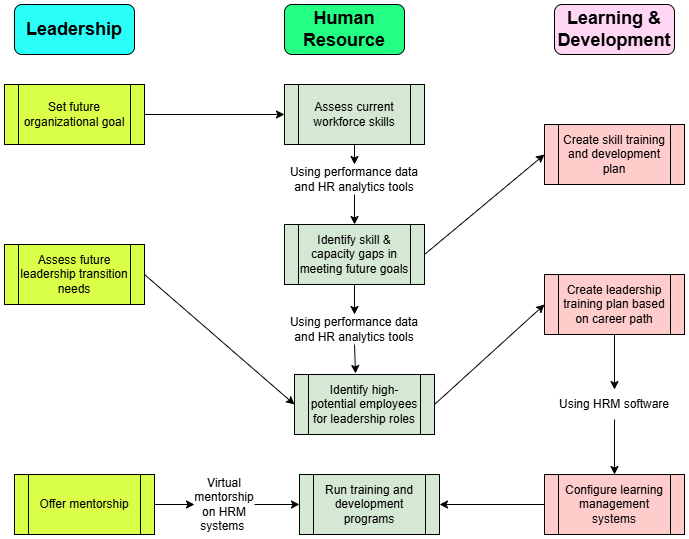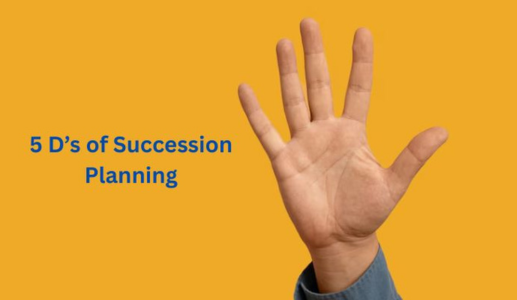HRM tools help integrate succession planning into the broader process of workforce planning. The integration helps:
- Ensure best-fit people in leadership positions.
- Improve employee morale and retention with internal promotions.
- Speed up hiring and reduce costs by filing roles internally.
- Ensure a ready pipeline to ladders ready to step up.
Organisations are interconnecting their workforce planning and succession planning processes. Although succession planning is a part of the broader workforce planning, a stronger strategic alignment increases the effectiveness of initiatives. But 46% of the board members still report not having an effective CEO succession plan.
In this article, you will learn how the two processes compare and contrast. You will also learn about the best integration practices and what to avoid.
What Is Workforce Planning?
Workforce planning is a strategic process. It involves analysis of the current and future human resource needs. This helps make sure that there are the right skills, people, and capacities to meet business goals.
Key Components
The main component of workforce planning is workforce analysis. You first set a strategic goal or direction. Then you examine if your current workforce can achieve performance targets to help meet organisational goals.
Reports reveal that organisations performing workforce planning have a 50% greater chance of achieving business goals. You identify the gaps between the current workforce capability and the future needs. Finally, you create a plan for closing the gap. You may develop existing employees or hire new people.
Why It Matters
Workforce planning matters as it helps develop talent for the future based on current skill gaps. It helps organisations realise the skills they need to meet future business goals. It allows organisations to make logical and informed decisions about talent development.
Employees become more skilled. Productivity and efficiency increase. Workforce capacity feels aligned with and right for meeting business goals. So, resource allocation is also optimised and cost is reduced. Workforce planning can help businesses save 10% on costs within a year.
What Is Succession Planning?
Succession planning is also a strategic process. It is about identifying the right employees and developing those internal candidates to take up key positions.
Key Components
The key component of succession planning is the identification of critical positions and their potential successors. Developing the competencies and skills of the potential successors is another important component. So, targeted development programs and training plans are also a vital component of succession planning.
Keeping a pipeline of qualified leaders ready to step up is another vital component of succession planning. So, you can ensure that an enhanced process is followed for developing leaders. Employees with great potential also get an opportunity to take on leadership positions.
Succession planning also helps avoid expensive outside hiring for filling leadership positions. Filling positions internally is 18% less expensive than outside hiring. Positions are filled internally, and with the right people from within the organisation.
The likelihood of outside hires quitting within the first year is 21%. Internal promotions improve retention rate as well. Promoting employees within three years of joining can increase their retention rate by 70%.
Why It Matters
Why is succession planning important? Well, it is about preparing employees proactively for leadership transitions. This ensures the growth and steadiness of the business in the long run.
Succession planning will help you minimise the risks associated with key people leaving your organisation. Around 60% of revenue can be lost by organisations if they don’t consider succession planning.
Filling up positions internally is important as people retire, get promoted, or quit. Performance reviews and readiness assessments are performed to identify potential successors. So, you can ensure the continuation of your business. You can also prevent disruptions resulting from key personnel moving on.
Succession Planning Vs. Workforce Planning: Key Differences
Here is an overview of the key differences between workforce planning and succession planning.
| Workforce Planning | Succession Planning | |
| Goal | Training employees for future business goals | Train employees for future leadership roles |
| Focus | Workforce skills and capacity building | Leadership pipeline building |
| Scope | Train internal employees or hire new candidates | Only prepare internal employees |
| Priority | Less skilled employees are a priority for training initiatives | High-potential employees are identified and prioritised |
| Strategy | Track performance to understand skill gaps | Track performance to identify high-potential employees |
Table 1: Workforce Planning vs. Succession Planning- An Overview
Where They Intersect: Strategic Alignment
Workforce and succession planning intersect at performance and skill management. The two processes prioritise organisational needs and talent development with different scopes.
Shared Goals
Both workforce and succession planning share the common objective of meeting the organisation’s future operational needs. Now, workforce planning considers the overall competencies and quantity of the workforce.
Succession planning is about filling vital leadership designations with internal talent. Both workforce and succession planning aim at reducing disruptions resulting from departing employees. So, identifying the skills gaps or developmental needs is also a shared goal of workforce and succession planning.
Complementary Strategies
Workforce and succession planning are two strategic processes that can complement one another. Workforce planning is focused on the skills and needs of the entire workforce.
Succession planning is focused specifically on developing existing high-performing employees to take up future leadership roles. So, you can use the two strategies for making your talent pipeline more robust.
Benefits of Aligning Workforce & Succession Planning
Alignment between the workforce and succession planning will make the transition process for leaders and employees smoother. It can also benefit your organisation in several other ways.
- Better Risk Management: Potential gaps between leadership and employee skills will be identified. This will ensure that your business operations are not disrupted when key personnel move out.
- Better Employee Retention: Employee retention will be improved. They will get a clear way to advance their careers. Employees’ morale will be boosted. You will be able to reduce the turnover rate and the related costs.
- Reduced Cost: You will be able to save on hiring costs. Internal promotion will help you avoid the need to run hiring programs or pay for recruitment services. So, hiring and onboarding will be less costly.
- Business Continuity Guarantee: Critical roles in your organisation can be filled out readily. So there will be less downtime and disruptions even in the case of sudden transitions or absenteeism.
- Strong Leadership Pipeline: You will not only have a skilled workforce, but also competent leaders. Employees will have the opportunity to develop role-specific as well as leadership skills.
- Improved Adaptability: The adaptability of your organisation will improve. Potential successors, future workforce needs, and current capacity will be identified. So, resources for employee training and candidate hiring can be allocated accordingly.
Best Practices for Strategic Integration
Now that you have a comparative overview of succession planning vs. workforce planning, let’s see the best practices to strategically integrate the two processes.
Step 1- Start with Business Goals
Clearly define the strategic goals of your organisation. Establish objectives for the upcoming 5 years. Set targets for areas like market share, revenue, innovation, and operational efficiency. Ensure that your objectives are specific, measurable, and time-bound.
Step 2- Use Integrated HR Tech & Analytics
You need to perform an analysis of your workforce with respect to the specified business goals. You also need to understand the skills and capacity needed to meet the objectives for the upcoming years.
Assess the current skills and experience of the current employees. Also, anticipate what skills and how many people you will need in the future. Measure the current performance. Anticipate future potential. Next, identify the skill gaps.
HRM (Human Resource Management) systems can help you with this stage. The systems will unify data from all departments, which will help you track employee performance. These systems also come with analytics that will offer you deeper insights.
Here is how integrated HR tech and analytics will streamline succession planning.
- AI-powered talent assessment helps identify high-potential employees.
- Predictive analytics help anticipate the likelihood of the high-potential employee succeeding in leadership roles.
- Learning Management Systems (LMS) help with leadership training curated to the career path of employees.
- Virtual training, simulated scenarios and gamification help improve strategic thinking and decision making skills needed by ladders.
- Feedback platforms help gain insights on the leadership potential of employees from managers and peers.
- Scenario planning tools help test leadership competencies and transition.
- Succession planning activities are integrated into the broader strategies of workforce management, like hiring, training and retention.
- Automation of reporting tasks creates real-time insights on succession process performance.
Step 3- Collaborate Across HR, L&D & Leadership
You need to collaborate with other departments to understand the key people expected to retire or move on soon. So, a formal plan must be developed. The plan should identify the potential successors.
You need to start making a list of potential successors for each future leadership role. Assess their readiness for the roles. You must then create plans to develop the listed potential successors for leadership roles. HRM systems offer historic data and real-time insights to help you easily identify potential successors.
The training plan must address the gaps in skills. The training plan for potential successors must also be incorporated into the broader workforce development plan. So, ensure that the workforce planning initiatives in your organisation also support the training needs of the potential successors.

Figure 1: Succession Planning- Collaboration Across Three Departments
Step 4- Continuously Update & Review Plans
Monitor the effectiveness of your development plans. Use HRM systems like Performance Management and Automated Talent Management Software to track performance after training initiatives are complete. Monitor throughout the training days to stop improvements. Make adjustments if business conditions or objectives change.
You must also make adjustments if skill improvements cannot be spotted. New talent trends and emerging technologies can also create the need to make adjustments. Make sure your plans make staff members competent in meeting future workforce and leadership succession needs.
Common Pitfalls to Avoid
Here are the common pitfalls to avoid when aligning succession and workforce planning.
- Avoid being biased. Avoid favouritism. It can result in high-potential candidates getting excluded.
- Don’t foster ambiguity around job or leadership roles. The roles and responsibilities must be clear. Only then will you be able to identify the skills needed for the roles.
- Don’t ignore lower-level positions. Plan development initiatives for all critical roles. Similarly, plan succession for all critical leadership positions.
- Consider cultural fit during succession planning. Innovation will be hindered if successors fail to align with organisational culture.
- Don’t neglect communication of the plans. You don’t want to create uncertainty, as it can lead to employees resisting the initiatives. Ensure clear and transparent communication.
Ready to Align Workforce & Succession Plan?
Succession planning is a part of border workforce planning. Both processes are focused on developing employees to meet organisational goals. But the scope differs.
Workforce planning is about making employees competent to meet future business goals. Succession planning is about making high-potential employees ready to take on leadership roles.
Aligning the two processes ensures that workforce development initiatives cover leadership succession needs. Get HRM systems to ensure easy and unbiased assessment of employee performance.





